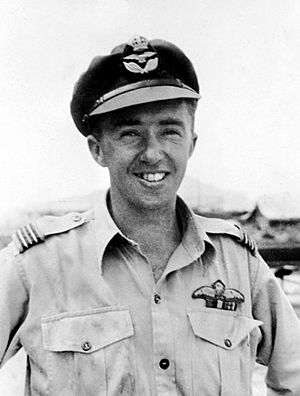Neville McNamara facts for kids
Quick facts for kids
Neville McNamara
|
|
|---|---|

Flight Lieutenant McNamara in Japan, 1947
|
|
| Born | 17 April 1923 Toogoolawah, Queensland |
| Died | 7 May 2014 (aged 91) Jervis Bay, New South Wales |
| Allegiance | Australia |
| Service/ |
Royal Australian Air Force |
| Years of service | 1941–84 |
| Rank | Air Chief Marshal |
| Unit | Central Flying School (1951–53) No. 77 Squadron (1953) |
| Commands held | No. 25 Squadron (1957–59) No. 2 OCU (1959–61) RAAF Ubon (1966–67) RAAF Forces Vietnam (1971–72) Chief of the Air Staff (1979–82) CDFS (1982–84) |
| Battles/wars | World War II Korean War Vietnam War |
| Awards | Knight Commander of the Order of the British Empire Officer of the Order of Australia Air Force Cross Air Efficiency Award |
Sir Neville Patrick McNamara (17 April 1923 – 7 May 2014) was a very important leader in the Royal Australian Air Force (RAAF). He reached the highest ranks in the Australian military.
From 1979 to 1982, he was the Chief of the Air Staff (CAS). This was the top job in the RAAF. Then, from 1982 to 1984, he became the Chief of the Defence Force Staff (CDFS). This was Australia's most senior military role at that time. He was only the second RAAF officer to become an Air Chief Marshal.
Neville McNamara was born in Queensland. He joined the RAAF during World War II. He flew P-40 Kittyhawk planes in the South West Pacific. He also flew Gloster Meteor jets in the Korean War. He was known for his strong leadership.
Contents
Neville McNamara's Early Life and World War II Service
Neville Patrick McNamara was born on 17 April 1923 in Toogoolawah, Queensland. He went to school in Toogoolawah and Warwick.
He joined the Royal Australian Air Force (RAAF) on 12 October 1941. After training, he became a sergeant pilot in 1942. He first worked as a flight instructor. Later, he became a fighter pilot in the South West Pacific. He flew P-40 Kittyhawk planes with No. 75 Squadron. He became an officer in 1944.
After the War: A Growing Career
Becoming a Senior Leader
After World War II, McNamara was sent to Japan. He was part of the British Commonwealth Occupation Force (BCOF) with No. 82 Squadron. He was promoted to flight lieutenant in 1946. In 1949, he worked in air traffic control.
He married Dorothy Miller in 1950, and they had two daughters. In 1951, he became an instructor at Central Flying School. He was promoted to squadron leader in 1952.
He then served in the Korean War with No. 77 Squadron. He flew Gloster Meteor jets. His squadron mainly attacked targets on the ground. McNamara briefly led the unit in late 1953.

In 1954, McNamara returned to Australia. He worked at Headquarters Training Command. He later became the Commanding Officer of No. 25 Squadron in Western Australia. He was promoted to wing commander in 1957.
In 1959, he took charge of No. 2 Operational Conversion Unit (No. 2 OCU). This unit trained pilots to fly the CAC Sabre jet fighter. For his excellent leadership, he received the Air Force Cross in 1961.
In the 1960s, McNamara went to the UK for further training. He then led the RAAF Staff in London. In 1966, he took command of RAAF Ubon in Thailand. This base had No. 79 Squadron flying CAC Sabres. The RAAF presence there was important for political reasons. He was promoted to group captain in 1968.
Leading the RAAF and Defence Force
In 1971, McNamara became the last Commander RAAF Forces Vietnam. He also served as Deputy Commander Australian Force Vietnam (AFV). He worked closely with army units to understand air support. He oversaw the withdrawal of the RAAF from Vietnam in 1972. For his great work, he was made a Commander of the Order of the British Empire.
In 1973, he became the Australian Air Attache in Washington, D.C., USA. He was promoted to air vice marshal in 1975. He then became the Deputy Chief of Air Staff in Australia. This role helped him prepare for the top job. In 1976, he was appointed an Officer of the Order of Australia for his distinguished service.
McNamara became Chief of the Air Staff (CAS) in March 1979. He was now in charge of the entire RAAF. He worked on new plans for Australia's air defence. He also oversaw the choice of the F/A-18 Hornet to replace the older Mirage III fighters. He preferred the F/A-18 because it could do many different jobs. In 1980, he was made a Knight Commander of the Order of the British Empire.
In 1982, McNamara made history. He became the first Air Force member to lead all three of Australia's armed services. This new role was called Chief of the Defence Force Staff (CDFS). He also became only the second RAAF officer to reach the rank of air chief marshal.
As CDFS, McNamara worked to improve relationships between military and civilian staff. He believed both groups were important. He also made sure military personnel wore their uniforms more often. This helped show the difference between military and civilian roles. The CDFS role was later renamed Chief of the Defence Force (CDF). This change made its authority over the Australian armed services even clearer.
Retirement and Legacy
Air Chief Marshal McNamara retired from the military in April 1984. In 2001, he received the Centenary Medal for his service to Australia. He also joined celebrations for the 80th anniversary of the RAAF.
McNamara wrote his autobiography, The Quiet Man, in 2005. He passed away on 7 May 2014, in Jervis Bay, New South Wales. He is remembered by his wife and two daughters. A street in North Turramurra, New South Wales, is named Sir Neville McNamara Drive in his honour.


